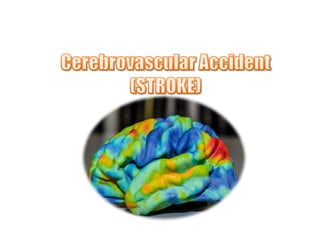
Cerebrovascular accident
- 2. • Stroke is a clinical syndrome characterized by rapidly developing clinical symptoms and/or signs of focal, and at times global, loss of cerebral function, with symptoms lasting more than 24 hours or leading to death, with no apparent cause other than that of vascular origin – WHO • TIA (Transient Ischaemic Attack) recovery is complete within 24 hours.
- 3. • 3rd most common cause of death in Malaysia NASAM 2013 • Incidence of Stroke in Malaysia increasing trend but inhospital mortality rate is in declining trend. Information and Documentation Unit, Ministry Of health 1998 • The incidence of stroke has been reported to be more in men compared to women (Hu et al, 1992; al-Rajeh et al, 1993; Lopez et al, 1995; Korv et al, 1996; Rozenthul- Sorokin et al, 1996)
- 4. • Every two seconds, someone in the world suffers a stroke. • Every six seconds, someone dies of a stroke. • Every six seconds, someone’s quality of life will forever be changed – he will be physically disabled permanently due to a stroke. REF : http://thestar.com.my/health/story.asp?file=/2011/10/30/health/9788575&sec=health
- 5. • 3 Simple Questions ☺Ask the person to smile ☺Ask the person to raise both arms ☺Ask the person to say a simple sentence “The sky is blue in Johor” The sky is blue in Johor
- 6. Sudden numbness or weakness of face, arm or leg, especially on one side of the body Sudden confusion, trouble speaking or understanding Sudden trouble seeing in one or both eyes Sudden trouble walking, dizziness, los s of balance or coordination Sudden severe headache with no known cause
- 7. Non-modifiable Modifiable Age (uncommon below 40) High blood pressure (systolic & diastolic) Sex M>F Cigarettes smoking Ethnic/race Diabetes melitus Family history of stroke Atrial fibrillation Coronary heart disease Hyperlipidemia Obesity & physical inactivity High dietary salt intake Heavy alcohol consumption Previous stroke High homocystein level
- 8. Atherosclerosis,thrombosis,embolism, arterial spasm,hypotension, Vasculitis cerebral venous infarction infarction Destruction of brain substance Mark oedema of surrounding brain Oedema of surrouding brain tissue HPT, aneurysm, bleeding diathesis, arteriovenous malformation neoplasm Space occupying lessions Expending mass from arterial haemorrhage Destruction of brain substance
- 9. Increase intracranial pressure Localizing sign (due to destruction of brain tissue/ Substance and oedema) Loss of sensation Slurred speech Numbness and weakness of Left upper limb Upper motor lession Left upper limb -hypertonia -hyperreflexia
- 11. Occlusion in brain blood flow ♣ Thrombotic stroke: clot forms in an area of atherosclerosis. Plaques that completely clog or markedly narrow an artery also can cause ischemic stroke. ♣ Embolic stroke: clot, or piece of plaque formed in one of the arteries leading to the brain or in the heart, is brought by bloodstream to lodge in narrower brain arteries.
- 12. Three main causes of ischemic stroke are: 1. Atherothromboembolism (50%) i. Large vessel occlusion or stenosis (e.g.: carotid artery) ii. Branch vessel occlusion or stenosis (e.g.: MCA) iii. Perforating vessel occlusion (lacunar infarction) 2. Intracranial small vessel disease (penetrating artery disease) (25%) i. Collagen disease e.g.: RA, SLE ii. Vasculitis e.g.: PAN, temporal arteritis iii. Granulomatous vasculitis e.g.: Wegener’s granulomatosis iv. Miscellaneous: syphilitic vasculitis, fibromuscular dysplasia, sarcoidosis, trauma 3. Cardiogenic embolism (20%) – Valvular heart disease,
- 13. Disease of Blood • E.g.: Coagulopathies, Haemoglobinopathies Venous Thrombosis • Venous Thrombosis may occur with infection and dehydration or in a/w arterial occlusion when related to estrogen excess (pregnancy, oral contraceptives) Decrease cerebral perfusion • Infarction between arterial territories may result from impaired perfusion e.g.: cardiac dysrhythmia, GI blood loss
- 14. Artery occluded Areas Infarcted Clinical Effect Anterior Cerebral Artery Frontal lobe Confusion, disorientated Motor and sensory cortex (leg area) C/lateral weakness, max in leg, cortical type sensory loss, max in leg Middle cerebral artery Lateral surface C/lateral hemiparesis, face>leg; c/lateral cortical type sensory loss Speech area (dominant) Expressive aphasia Optic Radiation Hemianopia Posterior cerebral artery Occipital lobe Cortical type-visual loss Vertebrobasilar arteries Cerebellum Intention tremor, incoordination, hypotonia Brain stem C/lateral hemiparesis and sensory loss; ipsilateral CN palsies
- 15. • Hemorrhagic stroke occurs when a vessel in the brain suddenly ruptures and blood begins to leak directly into brain tissue and/or into the clear cerebrospinal fluid that surrounds the brain and fills its ventricles.
- 16. • Hemorrhagic strokes are less common than ischemic strokes but cause a significant number of deaths worldwide. • Approx. 70-80% of all strokes are ischemic, 20-30% are hemorrhagic (10-20%-intracerebral hemorrhage 5-10% -subarachnoid hemorrhage) Kase et al., 2004
- 17. • The fatality rate for hemorrhagic strokes is higher than for ischemic strokes and the overall prognosis is poorer • It is the location of the hemorrhage, rather than the amount of bleeding, that tends to be the bigger factor in influencing the severity of the stroke. • For example, bleeds in the brainstem, though relatively tiny, can be quite lethal, whereas the same-sized bleed in the frontal lobe may not even be noticeable
- 18. A = Penetrating cortical branches ACA, MCA or PCA B = Basal ganglia C = Thalamus D = Pons E = Cerebellum
- 20. 1. Consciousness point i. Alert 0 ii. Drowsy and stupor 1 iii. Semicoma and coma 2 2. Vomiting/ headache within 2 hrs i. No 0 ii. Yes 1 3. Atheroma(diabetic history, angina, claudication) i. None 0 ii. ≥1 1 Formula: (2.5 x consciousness) + ( 2 x vomiting) + ( 2 x headache) + ( 0.1 x DBP) – ( 3 x atheroma) – 12 Diagnosis >1 cerebral haemorrage 90. 0%
